
It’s natural to question the comfort of barefoot shoes when you’re used to traditional cushioned footwear. These minimalist shoes can provide superior comfort by allowing your feet to move and function naturally. Thanks to their wide toe box design, you’ll experience a significant difference in how your toes can spread out and grip the ground. While the transition period may require some adjustment, most users report improved foot strength and reduced pain after switching to barefoot shoes. The thin soles help you feel the ground better, enhancing your balance and natural walking pattern. However, it would help if you started slowly to avoid potential discomfort or injury during the adaptation phase.
The Anatomy of Comfort in Barefoot Shoes
A proper understanding of barefoot shoe comfort starts with their unique design elements. Unlike conventional footwear, barefoot shoes focus on natural foot function rather than artificial support. Your feet can move, flex, and sense the ground as nature intended, improving balance and stability.
Wide Toe Box Benefits
Wide toe boxes allow your toes to spread naturally, giving you better balance and grip. Compared to traditional footwear, your toes can splay up to 15% more in barefoot shoes. This natural toe position helps prevent common foot problems and enhances your overall foot strength. You’ll notice immediate relief from the compression and improved circulation.
Natural Foot Alignment
Before wearing barefoot shoes, conventional shoe designs might have restricted your feet. The zero-drop sole in barefoot shoes places your heel and toes at the same height, promoting proper posture and natural walking patterns. Your body can now maintain its natural alignment from feet to spine.
In addition to improving your posture, natural foot alignment helps activate your muscles properly. Studies show that people wearing barefoot shoes experience a 40% increase in foot muscle activity compared to traditional shoes. This increased muscle engagement leads to stronger feet and better overall foot health.
Sensory Experience
The connection between your feet and the ground changes significantly with barefoot shoes. Your feet contain over 200,000 nerve endings, making them highly sensitive information gatherers. These shoes allow you to feel textures, temperatures, and terrain variations, giving you a better awareness of your environment and improving your natural movement patterns.
Ground Feel
About your connection to the surface beneath, barefoot shoes offer enhanced proprioception – your body’s ability to sense its position and movement. You’ll feel more stable and balanced as your feet receive direct feedback from the ground, helping you adjust your stride naturally and avoid injury.
Sole Thickness Variations
About the options available, barefoot shoe soles typically range from 3mm to 10mm thick. You can choose thinner soles for maximum ground feel or slightly thicker ones for additional protection while maintaining flexibility.
Sensory input varies with sole thickness, affecting how you experience the ground beneath your feet. Thinner soles (3-5mm) provide maximum feedback and are ideal for experienced users, while thicker soles (6-10mm) offer better protection for beginners transitioning to barefoot shoes. Your choice should align with your experience level and intended use.
Transition Process
Switching to barefoot shoes requires a careful and planned approach. It would help if you gave your feet time to adapt to the new minimal support. The transition can take 2-8 weeks, depending on your starting point. Start by wearing barefoot shoes for 30 minutes daily, then gradually increase the duration. This helps prevent potential injuries and allows your foot muscles to strengthen naturally.
Gradual Adaptation
After beginning your barefoot shoe journey, you should follow a structured progression. Start with short walks on smooth surfaces, then slowly add different terrains and longer distances. Your feet will need time to build strength and flexibility. Many users report improved balance and foot strength after 4-6 weeks of consistent wear.
Common Challenges
Common issues during transition include temporary muscle soreness, especially in your calves and feet. You might experience mild discomfort as your feet adjust to less cushioning. Some users report initial fatigue in their feet and lower legs as unused muscles begin working more actively.
The adaptation period varies significantly among individuals. You might notice increased sensitivity to ground textures and temporary arch discomfort. Statistics show that 85% of users successfully transition within 8 weeks following proper guidelines. The key is to listen to your body and adjust your transition pace accordingly.
Support Myths and Reality
Your feet have evolved over millions of years to function without external support. Modern shoe designs often weaken natural foot strength by providing artificial support that prevents your feet from working as intended.
Traditional Support vs. Natural Strength
Shoe manufacturers have promoted artificial arch support and cushioning as vital features for decades. However, these supports can prevent your feet from developing natural strength. Studies show that people who grow up without shoes have stronger, healthier feet and fewer foot problems.
Scientific Evidence
One key research finding shows that unshod populations have three times fewer foot deformities than those who regularly wear conventional shoes. Your feet contain 26 bones, 33 joints, and over 200,000 nerve endings that work together naturally.
Due to these findings, more podiatrists now recommend minimalist footwear that allows natural foot movement. Research indicates that transitioning to barefoot shoes can improve foot strength by up to 60% within six months, though this transition should be made gradually to avoid injury.
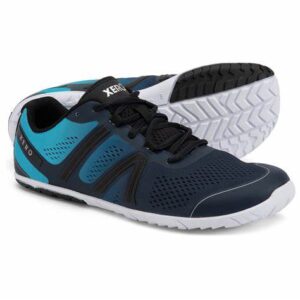
Physical Adaptations
Not everyone adapts to barefoot shoes at the same pace. Your body needs time to adjust to this new way of moving. During the transition period, which typically takes 2-8 weeks, you might experience some muscle soreness. This is normal and shows that your feet are getting stronger. Start with 15-30 minutes daily and gradually increase your wearing time.
Muscle Development
Barefoot shoes activate muscles across your feet and legs that traditional footwear keeps dormant. Your arch muscles become 40% stronger when you regularly wear minimalist shoes. You’ll notice increased strength in your calves, ankles, and foot muscles. This natural strengthening helps prevent common foot problems and improves your overall stability.
Gait Changes
By switching to barefoot shoes, you naturally shift from heel-striking to a more forefoot or midfoot strike. This change reduces impact forces on your joints by up to 30%. Your stride becomes shorter and more efficient, leading to better posture and reduced risk of running injuries.
Plus, the gait changes you experience help distribute pressure more evenly across your feet. Research shows that barefoot-style walking can reduce knee stress by up to 12%. Your toes spread wider for better balance, and your foot muscles engage more actively with each step, improving proprioception and overall movement control.
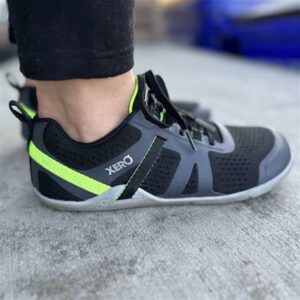
Comfort Considerations
All comfort aspects of barefoot shoes depend on your foot anatomy, activity level, and wearing history. While these shoes offer natural movement and toe freedom, your comfort experience will vary based on several factors. Any successful transition requires patience and proper adaptation time.
Individual Differences
An individual’s experience with barefoot shoes varies based on foot shape, arch height, and muscle strength. Your feet may need time to adjust to the minimal cushioning and zero-drop design. Any comfort issues usually resolve as your foot muscles become stronger.
Lifestyle Factors
An active lifestyle requires different considerations for barefoot shoe comfort. Consider these key factors:
- Daily walking distance
- Surface types you frequently walk on
- Standing duration at work
- Exercise routines
Any discomfort during transition can be managed by gradually increasing wear time.
Lifestyle choices significantly impact your barefoot shoe experience. Consider these additional factors:
- Weather conditions in your area
- Indoor vs outdoor activities
- Work environment requirements
- Travel frequency
Any adjustment period typically lasts 2-4 weeks for most users.
Conclusion
So, your journey to barefoot shoes can improve comfort and foot health. These shoes will be comfortable once your feet adjust to their natural position and movement. The wide toe box spreads your toes naturally, while the thin soles help you feel the ground better. Your feet will grow stronger without artificial support, and the zero-drop design will help your body maintain proper alignment. If you start slowly and give your feet time to adapt, barefoot shoes can offer a more natural and comfortable walking experience. Just choose the right pair and transition at your own pace.
FAQ
How long does it take to get comfortable with barefoot shoes?
The adjustment period varies for each person. New users typically need 2-4 weeks to adapt. Start by wearing barefoot shoes for 30 minutes daily, then gradually increase the duration. People who regularly walk barefoot or exercise may adjust faster. Those usually wearing high-heeled shoes might need 6-8 weeks to adapt.
Do barefoot shoes provide enough protection from sharp objects?
Yes, barefoot shoes offer adequate protection. The soles, while thin, use strong materials that block sharp objects. Most models have 3-6mm thick soles from durable rubber or similar materials. These soles protect feet from glass, rocks, and other hazards, allowing the ground feel and natural movement.
Can barefoot shoes help with foot pain?
Barefoot shoes can help reduce foot pain for many people. The wide toe box lets toes spread naturally, easing bunion pain and improving toe alignment. The flat, flexible sole helps strengthen foot muscles and can reduce plantar fasciitis symptoms. However, users should transition slowly and may need to build foot strength first. Some people might need medical advice before switching to barefoot shoes.

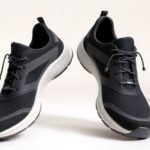


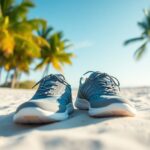
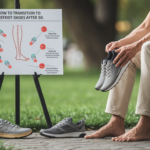


I can definitely relate to the initial skepticism about barefoot shoes, especially after years of relying on traditional cushioned footwear. It took me some time to fully embrace the concept, but once I did, I found that the benefits were truly transformative. The wide toe box has made a world of difference for my balance and stability. I remember my first few walks in them; it was a bit awkward at first, like relearning how to walk, but surprisingly rewarding.
I hear you loud and clear. Those first steps in barefoot shoes can feel a bit like trying to dance at a wedding after one too many drinks. You know the type—graceful one moment and flailing the next. But isn’t it something how your body starts to remember what it’s supposed to do?
It’s fascinating to hear how your journey with barefoot shoes mirrored many others. The initial adjustment phase can really feel like stepping into a new world altogether, can’t it? I remember when I first made the switch, too. There’s a certain vulnerability in going from what feels like being wrapped in a security blanket of cushion to a much more natural feel. It might seem odd at first—like your feet have to rediscover their own language.
It’s interesting to hear about your journey with barefoot shoes. That initial awkwardness is something many people experience; it’s almost like our feet need to remember how to do their job properly after being comfy in traditional shoes for so long. The wide toe box is a game changer, right? It really allows your toes to spread out and grip the ground, enhancing both balance and that natural feel while walking.
It’s really encouraging to hear how your journey with barefoot shoes has unfolded! That initial skepticism is totally understandable, considering the stronghold that traditional cushioned footwear has had on the market for so long. What you described about the awkwardness of relearning how to walk is such an interesting aspect of the transition. It’s like your feet are awakening to a different experience.
I appreciate the insights you’ve shared about barefoot shoes and their potential benefits. Transitioning to minimalist footwear is indeed a fascinating journey, and I can relate to the initial hesitations many people feel when stepping away from the cushioning and support of traditional shoes. Personally, I made the switch a couple of years ago after enduring persistent foot pain from more conventional styles. At first, I expected the transition to be challenging, but I found it refreshing to rediscover the natural way my feet were meant to move.
It’s interesting to hear about the benefits of barefoot shoes, especially given the current trend toward minimalism in various aspects of life, including footwear. I’ve been experimenting with them for a few months now, and while I definitely noticed the initial discomfort during the transition, I also found that it forced me to become more aware of how I walk and engage with my surroundings.
The discussion around barefoot shoes and their comfort is indeed thought-provoking, particularly in a society increasingly reliant on cushioned footwear that claims to alleviate discomfort. As someone who has journeyed from traditional shoes to minimalist footwear, I find the transition both enlightening and challenging.
I completely relate to the questions surrounding the comfort of barefoot shoes—it’s such a shift from the traditional cushioning we’re all used to. When I made the switch a couple of years ago, I was amazed at how liberating it felt to have my toes spread out and to really connect with the ground. It was a bit of a challenge at first; I remember having to take those slow steps you mentioned to avoid any foot cramps or soreness.
It’s great to hear your thoughts on the transition to barefoot shoes. That feeling of liberation is something many don’t expect until they actually experience it. It’s amazing how something as simple as giving your toes more room can shift how you connect with the ground beneath you.
You raise some valuable points about the transition to barefoot shoes and their potential benefits. Having made a similar switch in my own footwear choices, I can attest to the transformative impact they can have on foot health and overall comfort. Initially, I too found the idea of trading my cushioned sneakers for shoes that seemed so minimal daunting. There was a certain apprehension about whether my feet would be adequately supported. However, as I began the slow transition you mentioned—starting with short walks rather than jumping straight into longer runs—I experienced the gradual adaptation that many others have reported.
It’s really interesting to hear about your experience with the transition to barefoot shoes. I can relate to that initial uncertainty about giving up cushioned sneakers. It’s fascinating how our feet often adapt in ways we don’t expect. I remember when I first started, it felt almost rebellious to abandon the support I’d been so used to, but over time, I noticed my posture improving and even my running form becoming more natural.
It’s really refreshing to hear how your experience mirrors some of my own. That initial uncertainty can be a hurdle for many people—especially when we’ve grown so accustomed to the comfort of cushioned footwear. I remember feeling the same way when I first transitioned to barefoot shoes. It did feel a bit rebellious to break away from that conventional support, but it’s remarkable how our bodies can adapt and find their natural balance over time.
It’s interesting how that initial uncertainty can feel so weighty, right? I remember my first steps in barefoot shoes and thinking, “What did I just get myself into?” It felt like I was walking straight onto a tightrope without a safety net. But once I pushed through that awkward phase, it was like a light bulb went off. I started to really appreciate how grounded I could feel—like I was reconnecting with the ground beneath me in a way I’d forgotten.
I appreciate your perspective on the transition to barefoot shoes. It really is a journey, isn’t it? When I first considered making the switch, I had similar fears about support and comfort. I think a lot of people shy away from minimal footwear because it feels like such a radical change from the norm. But, as you’ve pointed out, starting with shorter walks is such a crucial part of that adaptation process.
Your experience really highlights what many people feel when making the switch to barefoot shoes. It can be a huge leap to move away from the cushy support we’ve grown accustomed to. Your method of taking it slow is spot on, and it’s amazing how our feet and bodies adjust over time. I remember when I first made the change, I felt like I was becoming more aware of how I walked and how my foot interacted with the ground.
I appreciate your thoughtful exploration of barefoot shoes and the nuances of their comfort. Transitioning to minimalist footwear is indeed a journey, and I think it’s fascinating how our society’s approach to foot health has evolved. Growing up, I remember the emphasis on cushioned shoes—it’s almost as if we were taught that the more support, the better. Yet, stepping into the world of barefoot shoes has opened my eyes to the importance of allowing our feet to operate in a more natural state.
It’s interesting how our perceptions of foot health have changed over the years, isn’t it? I can relate to your experience with the cushioned shoe craze; it felt like a rite of passage to have that extra support, almost as if we were protecting our feet from everything. Yet, as you mentioned, embracing barefoot shoes has provided a fresh perspective on how our feet are designed to function.
You’ve touched on a key point about how we view foot health. The cushioned shoe craze really did shape our understanding of what “support” means. It felt comforting, didn’t it? But stepping into barefoot shoes opened my eyes to how our feet are naturally designed to feel the ground and adapt.
I appreciate the way you highlighted the transition into barefoot shoes and the anatomical benefits they offer. Having made the switch myself, I can share that the journey has indeed been both challenging and rewarding. At first, the lack of cushioning felt odd, yet I quickly began to understand how much more connected I became to the ground beneath me. The natural grip and ground feel that minimalist shoes provide were unexpected advantages that improved my awareness of my surroundings and my foot placement while walking or running.
I can definitely relate to the skepticism around barefoot shoes! I remember my first attempt at making the switch—I felt like a toddler learning to walk all over again! Who knew there were so many tiny muscles in your feet just waiting to be activated? It’s like a gym session for my toes! And don’t get me started on that glorious feeling of letting your toes spread out. It’s basically like a mini celebration for your feet.
I appreciate your insights on the benefits of barefoot shoes. Transitioning to minimalist footwear has certainly been a journey for me as well. I found that the initial discomfort was manageable when I gradually increased my mileage, focusing on short walks and simple yoga poses that engaged my foot muscles.
I appreciate your insights into the comfort of barefoot shoes. Having made the switch myself, I can relate to the initial skepticism many feel, especially when coming from the plush support of traditional sneakers. It was indeed a transition—a gradual process where I had to listen closely to my body.
It’s interesting to see the growing conversation around barefoot shoes and their benefits. I’ve personally made the switch to minimalist footwear over the past year, and the difference in comfort and foot strength has been remarkable. Initially, I was skeptical about the lack of cushioning, especially since I had been accustomed to the plush support of traditional sneakers.
Your exploration of barefoot shoes really resonates with my own experiences and those of friends who have made the shift from traditional footwear. For years, I struggled with foot pain, and I would have never guessed my conventional shoes were a significant contributor. Transitioning to minimalist shoes was indeed a journey; the initial discomfort was challenging, but the eventual payoff—less pain and improved strength—made it all worthwhile.
Your insights into the comfort of barefoot shoes really resonate with me, as I’ve recently embarked on my own journey of transitioning away from traditional footwear. It’s intriguing to think about the extent to which our shoes influence not just our foot health but our overall posture and movement patterns. I had always relied on cushioned shoes, believing they were essential for comfort, but after some research into the benefits of natural foot function, I decided to give barefoot shoes a try.
It’s interesting to hear about your transition and the realizations you’ve had about footwear. Many people assume that more cushioning equals more comfort, but as you’ve discovered, that assumption can be misleading. While cushioned shoes may feel nice initially, they often mask the natural signals our bodies send us about how we walk and move.
It’s great to hear about your journey with barefoot shoes. I can relate to that transition; I used to be a die-hard fan of heavily cushioned footwear myself. When I first started researching the impact of traditional shoes on foot mechanics, it was quite eye-opening. It’s fascinating how something as fundamental as our footwear can influence not just our posture but also the way we engage with the ground.
Your exploration of barefoot shoes really resonates with me! I’ve recently transitioned to minimalist footwear, and I can attest to the benefits you mentioned. At first, it felt odd to have my toes spread out, but that freedom has made a noticeable difference in my overall comfort and stability. It’s fascinating how something seemingly simple, like the width of the toe box, can significantly impact our foot health.
You make an excellent point about the transition to barefoot shoes, particularly regarding the adjustment period. I can relate to the initial discomfort when making the switch from traditional cushioned footwear to minimalist options. It can feel like a drastic shift, but I found that gradually increasing my wear time helped significantly.